The SilverStone IceGem AIO Coolers Review: Going Big For Threadripper
by E. Fylladitakis on July 21, 2021 9:00 AM ESTMaximum Fan Speed
Our maximum speed testing is performed with both the fans and the pump of the kit powered via a 12V DC source. This input voltage should have the pump and fans matching the speed ratings of the manufacturer. SilverStone’s fans came close enough, with our tachometer reading 2180 RPM for the 120 mm fans and 1560 RPM for the 140 mm fans. These fans are rated at 2200 RPM and 1600 RPM respectively. Furthermore, the speed difference between the seven fans we tested was negligible, indicating great manufacturing quality and minimal tolerances.
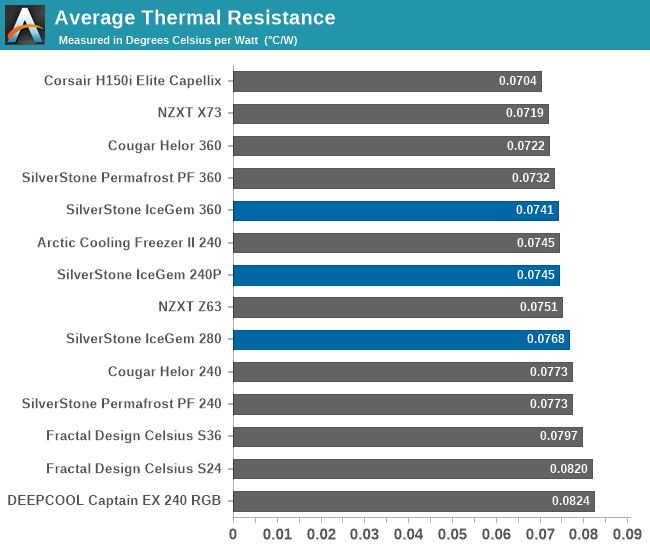
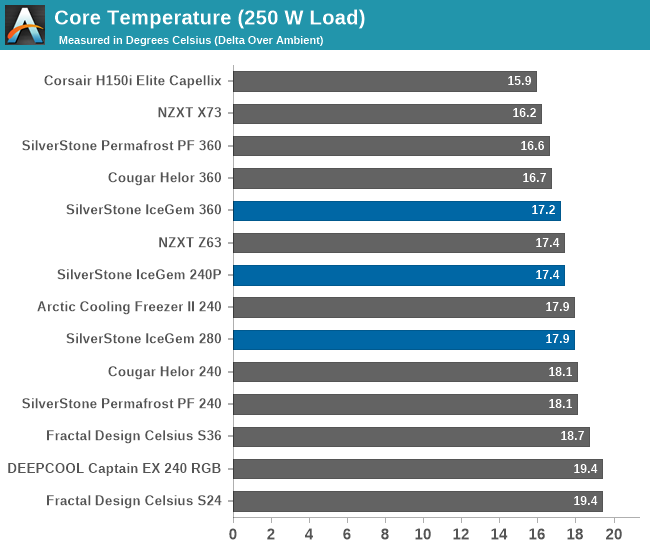
| Core Temperature, Constant Thermal Load (Max Fan Speed) |
A glance at the average thermal performance charts reveals a great surprise, with the IceGem 240P outperforming the 280 version and getting quite close to the 360 version as well. The 140 mm fans of the IceGem 280 are significantly quieter though, giving that cooler an advantage in acoustics. The average thermal resistance of 0.0745 °C/W is excellent for a cooler with two 120 mm fans, with the IceGem 360 sweating to get a tiny better thermal resistance figure of 0.0741 °C/W.


When it comes to acoustics, all of SilverStone’s new AIO coolers do exceptionally well, with low sound pressure levels across the board. What is interesting to note here is the very low sound pressure level of the IceGem 280, which gives the product a significant advantage against other coolers – even against the other two IceGem coolers.
Low Fan Speed
Using a PWM voltage regulator, we reduced the speed of the fans manually down to half their rated speed, which is 1080-1100 RPM for the 120 mm fans and 800-820 RPM for the 140 mm fans. The pump was also connected to the same power source, functioning properly at this low speed setting.

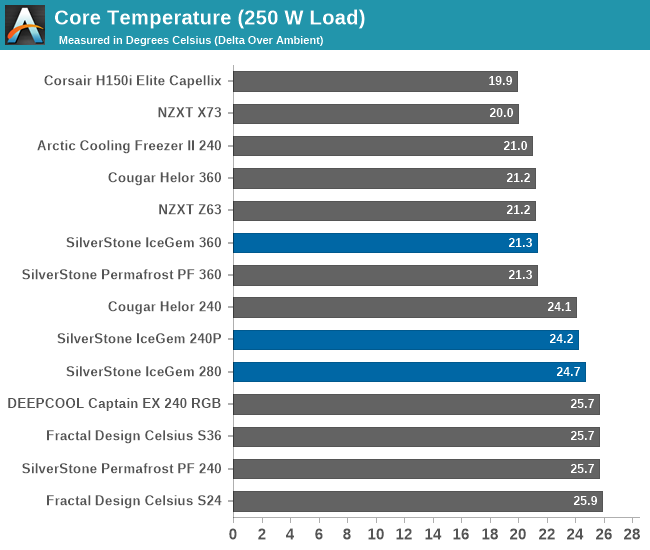
| Core Temperature, Constant Thermal Load (Low Fan Speed) |
The surprises continue in this test as well, with the IceGem 240P thermally outperforming the larger IceGem 280 even though the fans of the IceGem 280 should be pushing significantly more air through the radiator under these operating conditions. On the other hand, the IceGem 360 significantly outperformed the two smaller IceGem coolers and even the equally sized PermaFrost cooler by a very small margin.
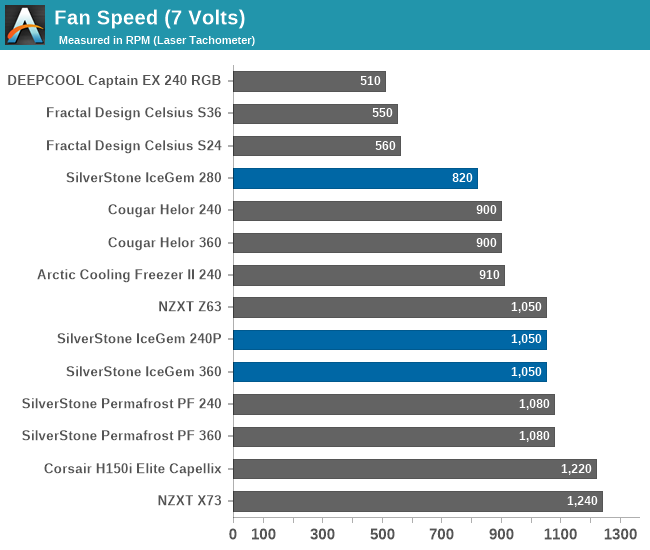

Even with these reduced speeds, the thermal permittance of the IceGem 360 rose only up to 0.0814 °C/W. In combination with the low noise output, that makes the IceGem 360 one of the most efficient coolers that we have ever tested. Although its thermal performance is not as great, we also received impressive sound pressure figures from the IceGem 280, which is nearly dead silent in this test. The IceGem 240P does not stand out in this test but it does perform comparatively well.
Thermal Resistance VS Sound Pressure Level
During our thermal resistance vs. sound pressure level test, we maintain a steady 100W thermal load and assess the overall performance of the coolers by taking multiple temperature and sound pressure level readings within the operating range of the stock cooling fans. The result is a graph that depicts the absolute thermal resistance of the cooler in comparison to the noise generated. For both the sound pressure level and absolute thermal resistance readings, lower figures are better.
This graph reveals that the IceGem 240P actually performs almost equally well, if not better, than the wider IceGem 280. We did not expect that the increase in the radiator’s thickness would be that beneficial, especially since the greater thickness also increases the airflow resistance of the radiator. We can also see that the IceGem 240P performs significantly better than SilverStone’s own Permafrost 240, which is using a 28 mm thick radiator. The IceGem 360 does outperform the smaller coolers when operating at low fan speeds but its thermal performance does not increase significantly with the fans operating at high speeds, making the cooler noisy for virtually miniscule improvements on the thermal performance.


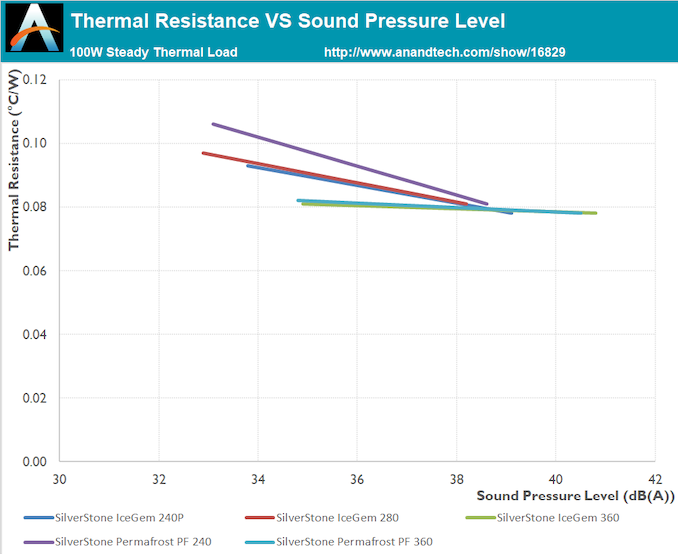








33 Comments
View All Comments
Threska - Saturday, July 24, 2021 - link
I think the larger point is that there isn't always an available choice. Sometimes the part we want is RGB or nothing. Not to mention the price could be larger for the RGB part.DominionSeraph - Sunday, July 25, 2021 - link
The issue is that there *is* no style or fashion with RGB. It's simply bad taste. No girl is going to walk into a room with an RGB setup and drop her panties because the fans light up and the keyboard is cycling through the rainbow. RGB is in the exact same vein as a racecar bed or Batman pajamas. If you're beyond the age of 10 and your taste hasn't matured into something with just a *little* more sophistication, it's a sign that something went wrong with your development.Oxford Guy - Sunday, July 25, 2021 - link
You’re paying for a feature you don’t want and other corners tend to be cut in terms of features you actually want.RGB stuff isn’t free.
DougMcC - Thursday, July 22, 2021 - link
I've never done a liquid cooled system. Could someone explain why the radiator on these coolers is designed to be mounted inside the case? Wouldn't it be drastically more effective if case makers designed for an external mount? Or am I just misunderstanding how you attach these to the case?meacupla - Thursday, July 22, 2021 - link
Yes, the best results can be had when you mount the radiator outside the case.But the results aren't drastically better when compared to mounting the radiator to the case's air intake.
Case makers tend to dislike external mounting of radiators, because buyers tend to want everything to be enclosed and look pretty. You would not only have the radiator dangling outside of the case, but you would also have the fan wires dangling out there too. It'll look like a cheap hack job.
swiftech and koolance used to make an external mount bracket for radiators, but now that most modern cases, especially the really large ones, are designed to accept 2 or more internally mounted radiators, why would AIO CLC makers bother to make an external one?
koolance still makes external radiators, but the cost on them is very high when compared to these internal AIO CLCs.
DougMcC - Thursday, July 22, 2021 - link
I see, thanks. I would think the dangling issues would be solved by having power delivered to the external radiator sleeved with one of the coolant tubes. Then you'd just have the pair of tubes into the case, and presumably the radiator top-mounted. Sounds like the cooling advantage isn't sufficient to drive adoption/standardization.Samus - Thursday, July 22, 2021 - link
This cooler is a weird size at 280mm, so it's likely only going to fit certain cases that use 140mm fans.Silverstone has moved to 140mm fans after trying 180mm fans as far back as the FT-01 Fortress. The 180mm fans were garbage and seemingly an exclusive Silverstone thing. I've had multiple fail over the years where the bearing shaft detaches. Other failures people have noted on the interwebs have shown the entire fan shroud detaches from the motor or the motor support beams on the back of the fan housing crack at the motor mount, both causing the fan to 'knock' as it spins off-center and makes contact with the case, filter, etc. Very unfortunate.
Anyway, basically the radiator attaches to the fan mounts of a case, with the fans mounted to the rear of the radiator. Some people do it the other way around, attaching the radiator to the fans. It depends what you desire for your cooling design (pusher fan vs puller fan) and some people do BOTH one in front and behind the radiator. The type of fan is an important consideration as well as most fans don't have high "static" pressure even if they are high RPM and rated at a high CFM. Static pressure traditionally isn't important unless you are trying to blow air through dense radiator fins, so sometimes the fan is more important than anything else, otherwise you won't remove much heat.
Awful - Thursday, July 22, 2021 - link
huh? 280mm using 2x140mm fans is absolutely one of the (3) standard sizes. Just about every AIO line comes in 240, 280, and 360mm...Threska - Thursday, July 22, 2021 - link
Have a Silverstone going on ten years plus. All fans top and bottom still going strong. Naturally regardless of fan one needs to keep them clean.tonyou - Thursday, July 22, 2021 - link
We haven't moved away from 180mm fans, in fact, we are still developing new models now. Engineering a fan with much heavier fan blade than typical 120mm x 25mm sizes was quite difficult as the rotational forces are exponentially higher. So material and bearing both have to be much stronger than typical 120mm/140mm fans. However, any external forces (such as debris or touching fan blade by accident) or slight tilt/angle enacted on our spinning 180mm also had significantly high risk of damage, so yeah, much less forgiving than smaller fans and that's why they may seem to be more fragile when in fact they are built better. With that said, we have been improving these 180mm fans over the years so the newer models and production batches should stand up better than their predecessors.